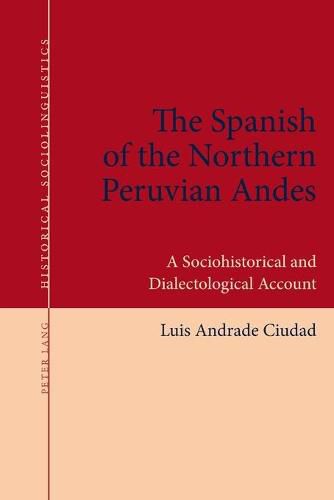Readings Newsletter
Become a Readings Member to make your shopping experience even easier.
Sign in or sign up for free!
You’re not far away from qualifying for FREE standard shipping within Australia
You’ve qualified for FREE standard shipping within Australia
The cart is loading…






This title is printed to order. This book may have been self-published. If so, we cannot guarantee the quality of the content. In the main most books will have gone through the editing process however some may not. We therefore suggest that you be aware of this before ordering this book. If in doubt check either the author or publisher’s details as we are unable to accept any returns unless they are faulty. Please contact us if you have any questions.
This book analyses a set of rarely described regional Spanish varieties spoken throughout much of the northern Peruvian Andes (Cajamarca, La Libertad and Ancash) from a sociohistorical and dialectological perspective. What are the main dialectological features of these varieties? Are these features the same ones that shape southern Andean Spanish, a variety formed mainly through contact with Quechua and Aymara? Which of these features are distinctly outcomes of contact with Culle, the main substrate language of the region, which was mentioned in colonial and postcolonial documents but is now extinct? How are these features linked to the postcolonial history of the region, marked by the Catholic evangelization enterprise and an economy of plundering based on agriculture, weaving and mining? Thorough consideration of these matters allows the author to critically assess the standard notion in Hispanic linguistics that considers Andean Spanish as a single, homogeneous code. The study sheds new light on how the regional varieties of Spanish in America were shaped over time and proposes ways of delving into language history in postcolonial contexts, where a written European language has been superimposed on a set of native codes previously lacking written traditions.
$9.00 standard shipping within Australia
FREE standard shipping within Australia for orders over $100.00
Express & International shipping calculated at checkout
This title is printed to order. This book may have been self-published. If so, we cannot guarantee the quality of the content. In the main most books will have gone through the editing process however some may not. We therefore suggest that you be aware of this before ordering this book. If in doubt check either the author or publisher’s details as we are unable to accept any returns unless they are faulty. Please contact us if you have any questions.
This book analyses a set of rarely described regional Spanish varieties spoken throughout much of the northern Peruvian Andes (Cajamarca, La Libertad and Ancash) from a sociohistorical and dialectological perspective. What are the main dialectological features of these varieties? Are these features the same ones that shape southern Andean Spanish, a variety formed mainly through contact with Quechua and Aymara? Which of these features are distinctly outcomes of contact with Culle, the main substrate language of the region, which was mentioned in colonial and postcolonial documents but is now extinct? How are these features linked to the postcolonial history of the region, marked by the Catholic evangelization enterprise and an economy of plundering based on agriculture, weaving and mining? Thorough consideration of these matters allows the author to critically assess the standard notion in Hispanic linguistics that considers Andean Spanish as a single, homogeneous code. The study sheds new light on how the regional varieties of Spanish in America were shaped over time and proposes ways of delving into language history in postcolonial contexts, where a written European language has been superimposed on a set of native codes previously lacking written traditions.